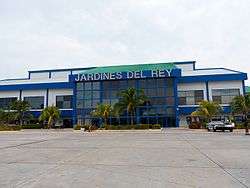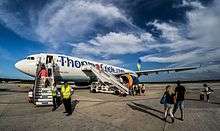Jardines del Rey Airport
| Jardines del Rey Airport Aeropuerto de Jardines del Rey | |||||||||||
|---|---|---|---|---|---|---|---|---|---|---|---|
 | |||||||||||
| IATA: CCC – ICAO: MUCC | |||||||||||
| Summary | |||||||||||
| Airport type | Public | ||||||||||
| Operator | Aena and ECASA | ||||||||||
| Location | Cayo Coco, Ciego de Ávila Province, Cuba | ||||||||||
| Elevation AMSL | 4 m / 13 ft | ||||||||||
| Coordinates | 22°27′40″N 078°19′43″W / 22.46111°N 78.32861°WCoordinates: 22°27′40″N 078°19′43″W / 22.46111°N 78.32861°W | ||||||||||
| Map | |||||||||||
 CCC Location in Cuba | |||||||||||
| Runways | |||||||||||
| |||||||||||
Jardines del Rey Airport (Spanish: Aeropuerto de Jardines del Rey) (IATA: CCC, ICAO: MUCC) is an airport situated on the island of Cayo Coco, part of the Cuban province of Ciego de Ávila. It takes its name from the Jardines del Rey archipelago, which includes Cayo Coco. Inaugurated in December 2002, the airport was built to better serve tourists to the island, who previously had to arrive at Máximo Gómez Airport about 70 kilometres (43 mi) to the south. Jardines del Rey Airport is the only airport in Cuba managed in part by a foreign company; Aena and ECASA jointly operate the airport. It receives well over 200,000 passengers per year, most of whom are foreign tourists.

History
In the early 1990s, the Cuban government began to develop the tourism sector in Cayo Coco, and several resorts were constructed. To reach Cayo Coco, tourists had to fly to Máximo Gómez Airport on the mainland and then take a one-hour bus ride to the island.[1] In order to make travel to Cayo Coco more convenient, the Cuban government announced in 1999 that it would build a new airport on the island itself.[2] Environmentalists disapproved of the site selected for the airport, but the government responded that the site was located in a zone already designated for infrastructure development. Meanwhile, the existing Cayo Coco Airport on the island, situated in a more environmentally sensitive area, would be demolished and reforested.[3]
Construction of the airport commenced in January 2000.[4] Later in the year, Spanish airports company Aena signed a contract with the Cuban government to build and operate the new airport, thus becoming the first foreign entity to manage a Cuban airport.[5] Management is shared with the Cuban company ECASA.[1] The first phase of the project was completed in early 2002, which encompassed the construction of the runway, taxiways, apron, air traffic control tower and a temporary terminal with a capacity for 150 passengers.[6] The airport was officially inaugurated on 26 December 2002 upon the completion of a larger terminal, which brought the airport's annual capacity to 1.2 million passengers.[4]
Infrastructure
The terminal is 64,600 square metres (695,000 sq ft) in size and can handle 600 passengers per hour. Its amenities include two VIP lounges, a snack bar, restaurant, duty-free shops and a currency exchange booth.[1]
Airfield
Jardines del Rey Airport has a single runway, 08/26, which measures 3,000 by 45 metres (9,843 ft × 148 ft) and is equipped with an instrument landing system.[7][8] The apron has three parking spaces and is connected to the runway by two taxiways.
Airlines and destinations
| Airlines | Destinations |
|---|---|
| Aero Caribbean | Havana, Holguín |
| Aerogaviota | Havana, Santiago de Cuba, Varadero |
| Air Canada | Seasonal: Halifax, Ottawa |
| Air Canada Rouge | Montréal–Trudeau, Toronto–Pearson |
| Air Transat | Montréal–Trudeau Seasonal: Halifax, Hamilton (ON), Québec City, Toronto–Pearson |
| Blue Panorama Airlines | Seasonal: Milan–Malpensa |
| Cubana de Aviación | Buenos Aires–Ezeiza, Havana Seasonal: Montréal–Trudeau |
| EuroAtlantic Airways | Seasonal charter: Lisbon |
| LOT Polish Airlines | Seasonal charter: Warsaw–Chopin |
| Nordwind Airlines | Seasonal charter: Moscow–Sheremetyevo |
| Silver Airways | Fort Lauderdale |
| Sunwing Airlines | Montréal–Trudeau, Toronto–Pearson Seasonal: Bagotville, Calgary, Edmonton, Halifax, Moncton, Ottawa, Québec City, Régina, Saint John (begins February 13, 2017),[9] Saskatoon, St. John's, Val d'Or, Windsor, Winnipeg |
| Thomas Cook Airlines | Manchester (UK) Seasonal: Glasgow, London–Gatwick |
| WestJet | Toronto–Pearson |
| XL Airways France | Paris–Charles de Gaulle (begins December 22, 2016)[10] |
Access
Jardines del Rey Airport is much closer to the resorts on Cayo Coco than Máximo Gómez Airport, which previously served the island.[1] A causeway links the airport and the rest of Cayo Coco to the Cuban mainland.[11]
References
- 1 2 3 4 "Jardines del Rey: international gateway to Cayo Coco". Cuba News. 1 April 2009. Retrieved 25 August 2016.
- ↑ "New airport planned". Caribbean Update. via HighBeam (subscription required). 1 February 1999. Retrieved 25 August 2016.
- ↑ "Cayo Coco & Cayo Guillermo becoming major tourism centers". Cuba News. via HighBeam (subscription required). 1 September 2000. Retrieved 25 August 2016.
- 1 2 "Abren aeropuerto internacional para dar servicio al turismo" [International airport to service tourism opened]. El Nuevo Herald (in Spanish). 28 December 2002. Retrieved 25 August 2016.
- ↑ "Spanish co. to manage airport". Caribbean Update. via HighBeam (subscription required). 1 June 2000. Retrieved 25 August 2016.
- ↑ "El nuevo aeropuerto internacional del polo turístico cubano Jardines del Rey comenzará a operar en enero" [New international airport in Cuban tourist centre Jardines del Rey will start operating in January]. Hosteltur (in Spanish). 16 October 2001. Retrieved 25 August 2016.
- ↑ "MUCC - Cayo Coco/Jardines Del Rey Airport". SkyVector. 21 July 2016. Retrieved 25 August 2016.
- ↑ Airport information for Jardines del Rey Airport at World Aero Data. Data current as of October 2006.
- ↑ Liu, Jim (15 June 2016). "Sunwing Airlines Adds New Routes in W16". Airline Route. Retrieved 23 September 2016.
- ↑ Liu, Jim (15 June 2016). "XL Airways France Adds Cuba Service in W16". routesonline. Retrieved 15 June 2016.
- ↑ "The Causeway to Cayo Coco". PBS. 23 September 2010. Retrieved 25 August 2016.
External links
![]() Media related to Jardines del Rey Airport at Wikimedia Commons
Media related to Jardines del Rey Airport at Wikimedia Commons